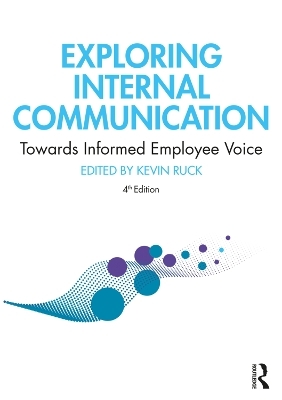
Exploring Internal Communication
Routledge (Verlag)
978-0-367-20011-4 (ISBN)
Exploring Internal Communication has long been the go-to publication for internal communication, public relations and human resources practitioners who want their practice to be grounded in research and guided by evidence-based advice. The new fourth edition has been comprehensively updated throughout to reflect the latest thinking in internal communication. Notably, the use of social media within organisations is explored in depth in recognition of the increasing integration of digital platforms.
A greater understanding of the different communication roles played by line managers and senior managers is emerging, and this is reviewed to help managers understand what is expected of them and how to succeed as they communicate with employees. And the demands of channel management are becoming increasingly complex; this edition helps practitioners negotiate this challenge.
Enriched with models, tips and case studies, this book is an indispensable tool for both students and practitioners alike.
Kevin Ruck is a founding director of PR Academy, the largest Chartered Institute of Public Relations qualifications centre providing education for communication professionals. He has more than 20 years’ experience in various communication roles within the telecoms and ICT sectors, latterly focusing on employee communication. Kevin holds an MBA with distinction and a PhD which incorporated an internal communication and engagement thesis. He is the course leader for PR Academy’s delivery of the CIPR Specialist Diploma in Internal Communication.
List of figures, List of tables, Notes on contributors, Preface by Kevin Ruck, PART I INTERNAL COMMUNICATION LEADERSHIP, 1. Internal communication and the associations with organisational purpose, culture and strategy, Kevin Ruck, Introduction, Responsible communication leadership, Organisational purpose and values, Internal communication and organisational culture, Internal communication and corporate strategy, Summary, 2. Theoretical and practical positioning of internal communication, Kevin Ruck, Introduction, Defining internal communication, Internal communication and the excellence theory of public relations, Internal communication and a rhetorical approach to public relations, Internal communication and a critical theory approach to public relations, Critical theory and power, Internal communication and relationship theory, Internal communication and employee voice, Internal communication and employee involvement and participation, Internal communication and distortion, democracy and cooperation, Summary of the academic literature, Practical positioning of internal communication, Summary, PART II GOOD PRACTICE, 3. The evolution of practice and the changing role of the practitioner, Heather Yaxley, Kevin Ruck and Ann Pilkington, The roots of modern-day internal communication – the employee publication, Propaganda or freedom: The editorial dilemma, New technologies and new thinking challenge the dominance of the house organ, Emergence of internal social media and employee engagement, Reflections on the evolution of practice, Contemporary internal communication practice, The internal communication function, Internal communication as a profession, Professional development of the internal communication practitioner, Effective business partnering, Summary, 4. Dimensions of internal communication and implications for employee engagement, Mary Welch, Introduction, Definitions, Evolution of employee engagement, Components of engagement, Further research, 5. Keeping employees informed and employee voice: Adopting an employee centric perspective Kevin Ruck, Introduction, Keeping employees informed: Topics of interest, Keeping employees informed: Quality of information, Defining employee voice, Receptiveness to employee voice, Employee voice mechanisms, Keeping employees informed and organisational engagement, Employee voice and organisational engagement, Summary, 6. The AVID framework for good and ethical practice, Kevin Ruck, Introduction, The research that informs the AVID framework, Information interests, Senior manager communication, Line manager communication, Employee voice, Dialogue, The AVID framework for good practice, Ethical practice, Summary, PART III STRATEGIC PLANNING PROCESSES, 7. The RADAR planning model, Kevin Ruck, Introduction, Importance of planning, The RADAR model for planning, Creative problem solving, Problem exploration - why technique, Problem exploration - other people’s definitions, Scenario planning, Setting objectives and targeting employee groups, Targeting employee groups, Strategic thinking, Tactics, Timescales and resources, Summary, 8. Project management, Ann Pilkington, Introducing projects, Defining scope and quality, The business case, Project roles: The project sponsor, Project roles: The project manager, Project roles: The project management office (PMO), Getting the requirements right, What does success look like? Estimating, Planning a project and the critical path, Change control, Risks and issues, How to understand a project, Reporting, Project methodologies, Summary, 9. Change communication, Paul Harrison, Why does change communication matter? What is this thing called change? Where can change communication go wrong? What can change management theory tell us? What makes behavioural change happen? What causes resistance to change and how should it be addressed? What content do staff want in change communication? How can managers lead the organisation through change? Getting change communication right, Summary, 10. Measurement, analysis and evaluation: The ICQ10, Kevin Ruck, Introduction, The continuous measurement cycle, Why is measurement important? A short history of approaches to measurement, The AMEC Integrated Evaluation Framework, The CIPR Inside Measurement Matrix, Using questionnaires, The ICQ10, Data analysis, Qualitative research, Interviews, Focus groups, Analysing interviews and focus groups, Summary, PART IV CONTENT AND CHANNEL MANAGEMENT, 11. Medium theory: Channels and content, Kevin Ruck, Introduction, Medium theory, Information richness, Channel preferences, Channel attributes, Channel usage and perceived effectiveness, Mapping content to channels, Champions for Health campaign: Correlating channels to outcomes, Summary, 12. Applying models from communication theory and psychology to practice, Kevin Ruck, Introduction, The ‘communication’ in internal communication, Attitudes and behaviour, Interpersonal communication, Framing and nudge theory, Summary, 13. Storytelling is serious business, Laoise O’Murchu, Introduction, Why should internal communication practitioners and senior managers pay attention to storytelling? Why doesn’t the facts and figures approach to communication work? Why don’t we use stories? How to tell stories, Can stories be used in business? Why does hearing a story make us less critical and less judgemental? Summary, 14. Getting the language and tone right, Ellen Hake, Introduction, Why language and tone matter, The six keys to effective communication, PART V THE DIGITAL WORKPLACE, 15. Communication on internal digital platforms, Peter Cardon, The evolution of internal digital platforms, The ideal culture on internal digital platforms, Ideal communications of managers on internal digital platforms, The ideals of two-way communication, transparency, and employee voice on internal digital platforms, Communicators as gatekeepers on internal digital platforms, Facilitating employee voice on internal digital platforms, Summary, 16. From message gatekeeper to true business enabler: Internal communication and a social way of working, Rita Zonius, Internal communication is being disrupted, just as the businesses we work for are too, Reinventing the role of internal communication for a social world, The big opportunity for social technology – enabling business progress in a knowledge economy, The typical business need for enterprise social technology, Democratising organisations and the flow of information, Introducing enterprise social? First focus on people and purpose, Preparing your people leads to better business outcomes, Watch for bumps in the road - identify and mitigate risks, Activating a social way of working – ideas to get you started, Leaders need to be social too, Advice for your leaders, A social way of working – use cases for communicators and the business, Meet the community manager – the ultimate enterprise social networker, Step up and encourage value exchange in enterprise social networks, 17. Automation and Artificial Intelligence: The reinvention of practice, Rachel Royall and Kevin Ruck, Preamble, Definitions, The potential impact of automation and AI on the future of work, How automation and AI might impact public relations and internal communication practice, The impact of automation and AI on internal communication competencies, New applications, new transdisciplinary role? Trust and ethics, Summary, Index
| Erscheinungsdatum | 16.12.2019 |
|---|---|
| Zusatzinfo | 36 Tables, black and white; 27 Line drawings, black and white; 1 Halftones, black and white; 64 Illustrations, black and white |
| Verlagsort | London |
| Sprache | englisch |
| Maße | 174 x 246 mm |
| Gewicht | 540 g |
| Themenwelt | Wirtschaft ► Betriebswirtschaft / Management ► Personalwesen |
| Wirtschaft ► Betriebswirtschaft / Management ► Planung / Organisation | |
| Wirtschaft ► Betriebswirtschaft / Management ► Unternehmensführung / Management | |
| ISBN-10 | 0-367-20011-2 / 0367200112 |
| ISBN-13 | 978-0-367-20011-4 / 9780367200114 |
| Zustand | Neuware |
| Informationen gemäß Produktsicherheitsverordnung (GPSR) | |
| Haben Sie eine Frage zum Produkt? |
aus dem Bereich


